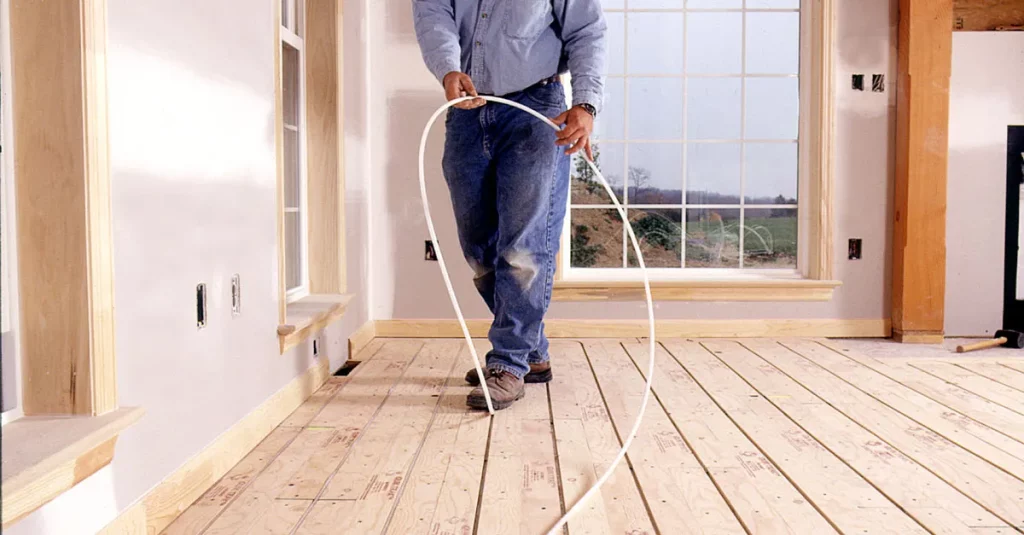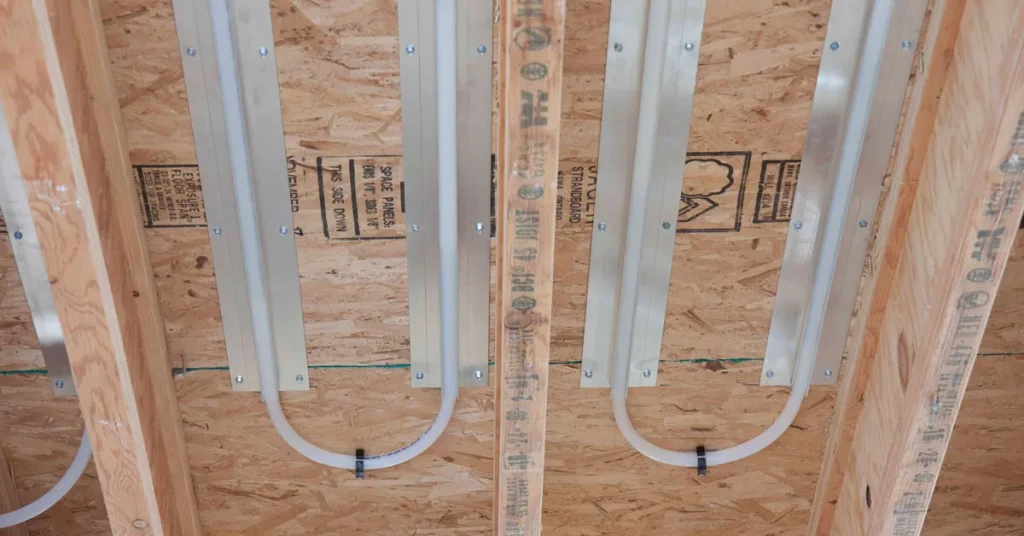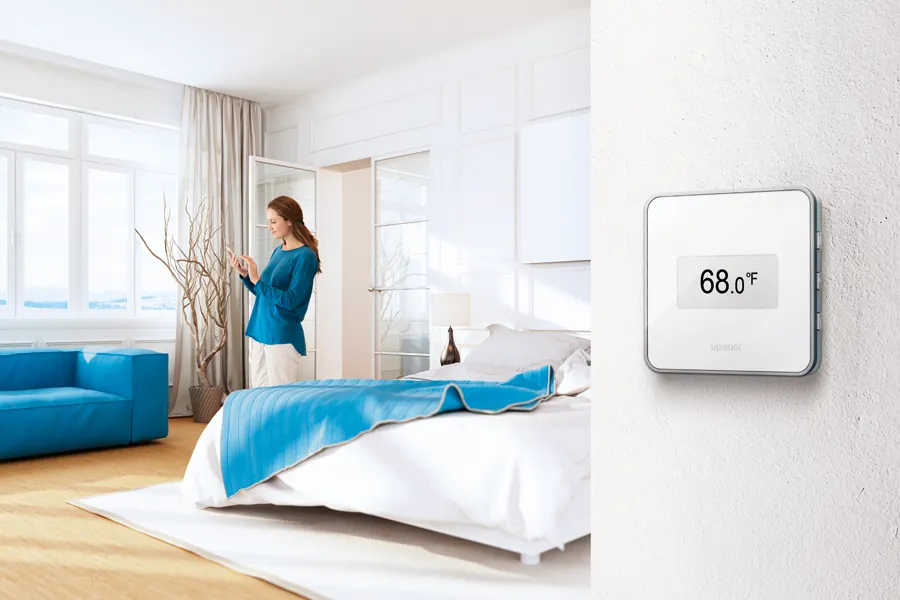Uponor Smatrix Pulse for Contractors
Why Radiant Heating is Trending in New-Home Construction and Remodels
With many people now spending time in their homes as both a workplace and a residence, this lifestyle shift has launched a focus toward healthier, more sustainable homes.
Now, homeowners are considering the total indoor environmental quality (IEQ) of a home, from indoor air to lighting to acoustics to comfort. And when it comes to IEQ, there is one home heating solution that far exceeds the requirements of a quality indoor environment — it’s radiant heating.
How Radiant Heating Works
Dubbed the most comfortable, energy-efficient method for conditioning a home, radiant heating works under floors (and even behind walls and ceilings) to create active thermal surfaces that radiate an even warmth throughout a space.
Flexible polymer pipe called “PEX” transports warm water through radiant loops or “zones”. As the energy flows through the piping system, it “radiates” warmth to surfaces, objects, and people.
The radiant PEX piping can be installed via various methods, including:
- Embedded in concrete (ideal in basements, garages, or slab-on-grade homes)
- Under the floor between joists (perfect for remodels when you don’t want to disturb the flooring above)
- On top of the subfloor in panels (also ideal for remodels or finishing basements when the concrete is already poured)
- Stapled down to the subfloor (cost-effective method for new construction)
How Radiant Improves a Home’s IEQ
Air Quality
Because radiant heating systems use pumps to move water instead of fans or blowers to push air, the system does not circulate dust, allergens, odors, or viruses throughout a home. In fact, people with severe allergies have found relief after installing radiant along with hard-surface flooring, instead of carpet.
Radiant systems are also beneficial for minimizing the transfer of odors around a home. To read all about the indoor air quality benefits of radiant, check out this article in Green Builder magazine.
Quieter Environment
Traditional HVAC systems are known for their telltale sounds — the furnace turning on, the air rushing through the vents, and the booming of the ductwork as it repeatedly heats and cools throughout the day and night.
Radiant heating, however, is quiet. All the parts, including manifolds, actuators, pumps, boilers, and piping, all silently work to circulate comfort throughout a space. Best of all, radiant systems don’t require the same type of costly maintenance as traditional HVAC systems.
Gone are the days of air filter
replacements and furnace tune-ups.
Superior, Even Comfort
Radiant heating most closely aligns with the ideal heating curve for the human body. On the flip side, forced-air HVAC systems are the most divergent from the ideal heating curve. This is why people who experience radiant say it’s the most comfortable form of heat they have ever felt.
Also, because radiant systems provide an even heat that reaches every inch of the floor, there are no hot or cold spots and there are no drafts like with forced-air systems. With radiant, there is a consistent, even comfort at all times.
Zones
Zones in a radiant system are what make it so comfortable as well as energy efficient. Because radiant systems are designed in zones, different areas of a home can have different temperatures based on need.
For example, a basement or living room can be set to 72°F, but a rarely used den can be set to 60°F. This individualized comfort control is typically one of the favorite features homeowners enjoy with radiant heating.
And since the spaces that aren’t getting used are at a lower thermostat setting, the home is more energy efficient because it isn’t wasting energy heating unused spaces.
Energy Efficiency
Now, let’s dive into the energy efficiency of radiant heating. A properly designed and installed radiant heating system will always be more energy efficient than a forced-air heating system. That’s because water has the capacity to transport energy 3,500 times greater than air. Hence, a hydronic radiant heating system
that uses water to heat a space rather than air will be much more energy efficient.
Hydronic radiant floor heating systems can also become even more energy efficient when paired with sustainable heat sources, such as geothermal and solar. In fact, these types of systems can potentially provide a structure with free heat, which is the smartest form of energy-efficient comfort.
What are the Components in a Radiant Heating System?
A radiant heating system consists of five main components:
- Heat source (boiler or heat pump)
- Circulator (moves the water around the system)
- Manifold (distributes water from the heat source to the tubing)
- Tubing (distributes water through each zone)
- Control system (manages comfort levels)

Quik Trak®
With a thickness of only ½”, Quik Trak® radiant wood panels are an ideal solution for remodel and retrofit applications. The panels simply fasten to the plywood subfloor and feature a groove down the center for the piping placement.
An aluminum sheet on the bottom of the panel increases the heat transferability. This method offers several advantages in addition to the minimal increase in floor height, including no moisture from concrete overpours and increased BTU output potential over joist heating.
Fast Trak™
Knobbed mats are becoming a more widely used option for radiant floor heating due to their ease of use. Available with or without insulation built in underneath, Fast Trak™ mats come preformed with knobs throughout the
surface which make it easy to “snap” the pipe into place.
Simply adhere the mats to the concrete slab or wood subfloor and press the pipe between the knobs (either by foot or by hand). After the pipe is installed, it is then covered with a lightweight gypsum overpour to create a smooth, solid surface for the flooring.


Joist Trak™
Aluminum is an excellent conductor of heat, so using Joist Trak™ aluminum heat-transfer plates is an effective way to install a high performing radiant floor heating system when installation on the surface of the floor is not an option.
The plates fasten to the underside of the subfloor between the joists and feature a
channel down the middle where the piping locks into place. Note that after installation, it is important to add a minimum R-11 fiberglass insulation into the joist bay snug against the plates to prevent downward heat loss
Beyond the Floors
When floor installation isn’t an option, consider radiant walls or ceilings. Quik Trak and Fast Trak are perfect for radiant wall applications, and Joist Trak is great for radiant ceilings. Some installers have even used radiant in really unique applications, such as behind bathroom mirrors to keep them from fogging up or within towel racks so homeowners can enjoy a warm towel right out of the shower.

Finding the Right Control System
Once you have chosen the right installation method for your project, the next step is choosing the control system. There are many different radiant control systems available, but only one can provide both radiant and forced-air control in multiple zones in a home — that’s Smatrix Pulse.

Smatrix Pulse is the newest innovation in controls from Uponor. It offers precise wireless control of radiant floor heating as well as forced-air heating and cooling systems, all with one solution that connects to a smart home assistant and can also be controlled remotely via an app.
Its state-of-the-art wireless technology provides freedom to place thermostats anywhere in the home — eliminating the time and hassles of wiring. Best of all, setup is a breeze with the installation wizard in the app (no Internet needed).
The unique “autobalancing” technology in Smatrix Pulse eliminates manual balancing of the system to save you time on the job site. Plus, it also provides faster system reaction times and greater energy savings for customers once the system is up and running. To find out where to buy Smatrix Pulse as well as all other Uponor radiant products, contact a local distributor in your area.
Getting a Proper Radiant Design
It’s important to remember that a radiant heating system is only as energy-efficient, comfortable, and sustainable as its design. There are several factors that go into a radiant design, including insulation, heat loss, pump and boiler size, loop lengths, window and flooring types, and more. So, it is extremely
important to get professional training or expert design support.
Uponor offers design services, online training, and technical support to help ensure the radiant system you install will provide your customers with the comfort and efficiency they expect.
To learn more about Uponor services, solutions, and support, contact one of our manufacturer reps in your area.
